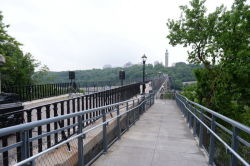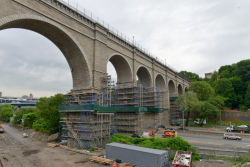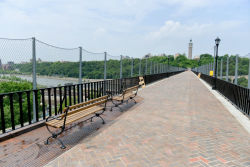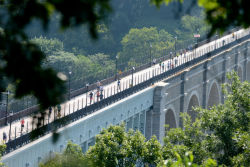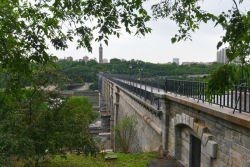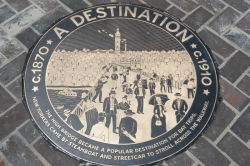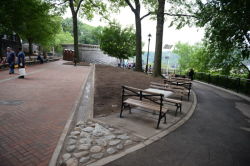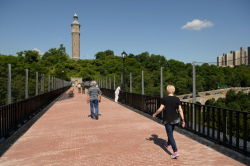Highbridge Park
Highbridge Park
Highbridge Park, located on West 170th Street, University Avenue, and the High Bridge derives its name from New York City’s oldest standing bridge. The High Bridge (1848) was built to carry the Old Croton Aqueduct over the Harlem River.
The High Bridge was once part of the first reliable and uninterrupted water supply system in New York City. As the city was devastated by fire and disease in the 1830s, the inadequacy of the water system of wells and cisterns became apparent. Numerous corrective measures were discussed. In the final analysis only the Croton River, located in northern Westchester County, was found to be sufficient in quantity and quality to serve the needs of the city. The delivery system was begun in 1837, and was completed in 1848.
The Old Croton Aqueduct was the first of its kind ever constructed in the United States. The innovative system used a gravity feed, running 41 miles into New York City through an enclosed masonry structure crossing ridges, valleys, and rivers. The High Bridge soars 138 feet above the 620 foot-wide Harlem River, with a total length of 1450 feet. The bridge was designed with a pedestrian walkway atop the Aqueduct and was not used for vehicular traffic. In the 1920s, the bridge's center masonry arches were declared a hazard to navigation and replaced by a single steel span.
One of Manhattan’s most picturesque landmarks, the water tower across the river has looked over old High Bridge and the Harlem River valley since 1872. In 1958, the tower was rehabilitated and outfitted with a five-octave carillon in memory of Benjamin Altman. The High Bridge and surrounding land came under Parks jurisdiction in 1960.
The City of New York acquired this property in 1837 in conjunction with the construction of the Old Croton Aqueduct. In 1937, the property became parkland when it was transferred from the Department of Water Supply, Gas and Electricity. Parks was granted surface rights only. The rest of the property was transferred to Parks in 1960.
Council Member Wendell Foster funded a $739,000 renovation that was completed in 2001. The work included a new overlook siting area, steel bar fencing, game tables, benches, brick and colored concrete pavements, a ramp, handrails, steps, curbs, plantings, drinking fountain, stone veneer wall, park identification plaque, lighting, and a thematic spray shower water feature to capture the spirit of the aqueduct.
Check out your park's Vital Signs
Clean & Safe
Green & Resilient
Empowered & Engaged Users
Share your feedback or learn more about how this park is part of a
Vital Park System

